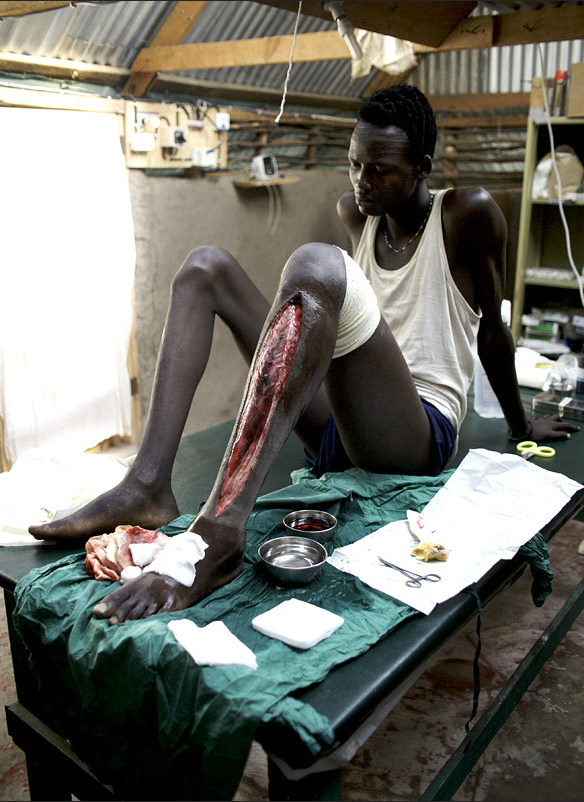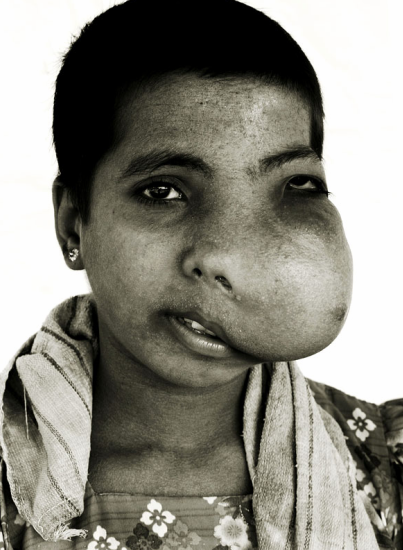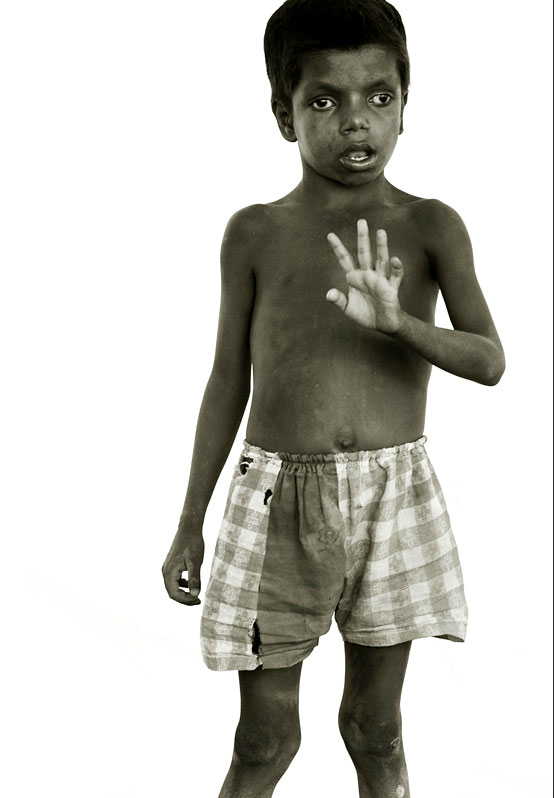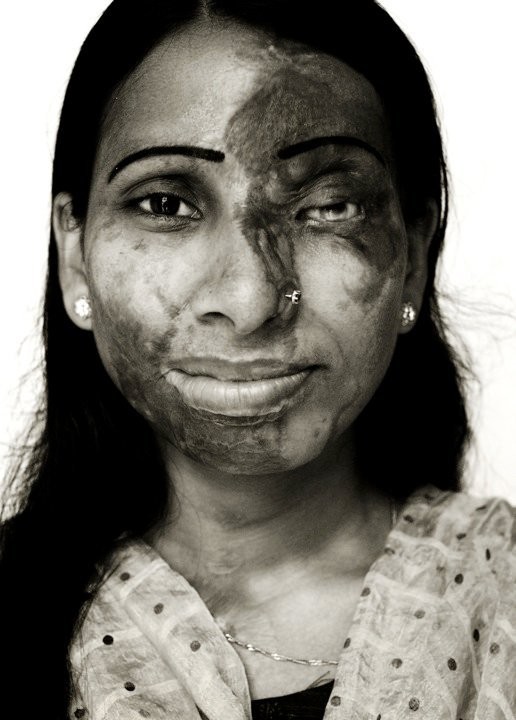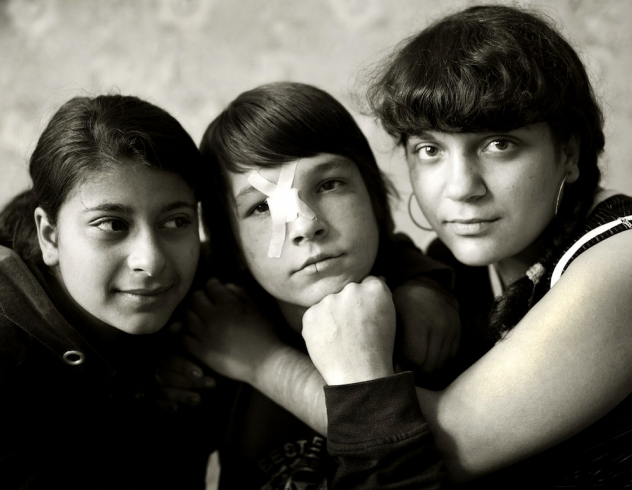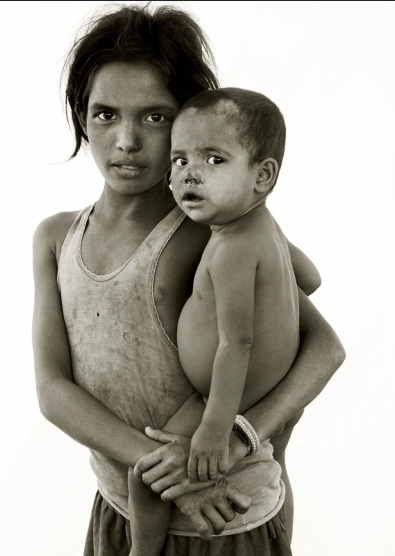Giles Duley has been getting a lot of attention recently as the photographer who lost both his legs and an arm after stepping on a landmine in Kabul while documenting American troops in Afghanistan. Giles has been reluctant to speak about himself and his accident, but it's the work that he's been compiling for the past ten years that I really wanted to talk to him about.VICE: Hi, Giles. Can you tell me about your trip to visit the refugees on the Burma/Bangladesh border?
Giles Duley: That was exactly the kind of story that I love to work on—and I know that VICE does very similar sorts of things. Refugees were coming out of Burma, and the Burmese said they were Bangladeshis while the Bangladeshis said they were Burmese. So nobody wanted them, and they kept getting passed around. It was insane enough that people were starving to death and dying from basic illnesses, but even the UN wasn't prepared to help them. It was bizarre—we were staying in Cox’s Bazar, which is the center of the Bangladeshi surfing scene, then you drive a couple of miles inland and suddenly you’re in these refugee camps.
Giles Duley: That was exactly the kind of story that I love to work on—and I know that VICE does very similar sorts of things. Refugees were coming out of Burma, and the Burmese said they were Bangladeshis while the Bangladeshis said they were Burmese. So nobody wanted them, and they kept getting passed around. It was insane enough that people were starving to death and dying from basic illnesses, but even the UN wasn't prepared to help them. It was bizarre—we were staying in Cox’s Bazar, which is the center of the Bangladeshi surfing scene, then you drive a couple of miles inland and suddenly you’re in these refugee camps.
Advertisement

Portrait by Jake Lewis.The camps look a little like favelas from your photos.
Yeah. There's an official camp, but they’re only allowed [to have] 25,000 people. So some of the asylum are forced to live below, where all the sewage from above runs down into their shacks.Jesus. Your photos show the effects of some of the really nasty diseases caused by those conditions as well, right?
Yeah. The most basic of mistakes cost lives there. One kid had scratched her eye, which then got infected, and without antibiotics or access to local doctors, her face swelled up to the point of choking her to death. They’ve been left there some 20 years without any real help, so that’s the kind of story I want to tell. One of the village elders put the word out that I wanted to take photos, then the next day a whole mass of people brought all their injured and dying relatives. At first I thought, "Shit, they think I'm a doctor," but then I realized they just wanted someone to tell their story. That's when I learned that a photo can give people who are otherwise hopeless a real sense of empowerment.You've spoken before about an ethical battle you’ve felt within yourself when taking challenging photos. Could you describe the inner process behind your photo of the young boy who was losing his fight to survive in Sudan?
I remember the first time I really felt it: ten years ago when I was in Angola photographing people in really shitty situations, and it hasn’t left me since. That case in Sudan was a 12-year-old boy who'd been shot in the stomach and arm. He was alone, and it didn’t look like he would make it—he was just a terrified boy on his own. So yes, it’s incredibly hard to make that ultimate decision: Do you take a photograph? You tell yourself you’re there for the right reasons, and that’s important in telling the story. But, as a human being, if you didn’t feel some sort of remorse then, there’d be something fundamentally wrong with you. It doesn’t seem to bother some photographers at all, though.
Yeah. There's an official camp, but they’re only allowed [to have] 25,000 people. So some of the asylum are forced to live below, where all the sewage from above runs down into their shacks.Jesus. Your photos show the effects of some of the really nasty diseases caused by those conditions as well, right?
Yeah. The most basic of mistakes cost lives there. One kid had scratched her eye, which then got infected, and without antibiotics or access to local doctors, her face swelled up to the point of choking her to death. They’ve been left there some 20 years without any real help, so that’s the kind of story I want to tell. One of the village elders put the word out that I wanted to take photos, then the next day a whole mass of people brought all their injured and dying relatives. At first I thought, "Shit, they think I'm a doctor," but then I realized they just wanted someone to tell their story. That's when I learned that a photo can give people who are otherwise hopeless a real sense of empowerment.You've spoken before about an ethical battle you’ve felt within yourself when taking challenging photos. Could you describe the inner process behind your photo of the young boy who was losing his fight to survive in Sudan?
I remember the first time I really felt it: ten years ago when I was in Angola photographing people in really shitty situations, and it hasn’t left me since. That case in Sudan was a 12-year-old boy who'd been shot in the stomach and arm. He was alone, and it didn’t look like he would make it—he was just a terrified boy on his own. So yes, it’s incredibly hard to make that ultimate decision: Do you take a photograph? You tell yourself you’re there for the right reasons, and that’s important in telling the story. But, as a human being, if you didn’t feel some sort of remorse then, there’d be something fundamentally wrong with you. It doesn’t seem to bother some photographers at all, though.
Advertisement

You’ve said your intention is never purely to shock people with your photography; you always want to focus on a particular angle or how lighting affects the scene.
When it came to taking the picture of the Sudanese boy, I decided not to show his injuries, which is harder in a way because you have to connect with the person. So, you’ve got a 12-year-old who’s dying in front of you, staring at you as you’re taking his picture. People often say to me, "Oh, you’re just like a vulture." But in a situation like that, I’d only ever take a couple of frames, and the only thing I could do was sit with him for the rest of the day. You can try to do it in the "right" way, but it’s never easy.Did the dynamic change between you and the subjects of your photography when you went back to Afghanistan? Did you feel less of an intruder and more like someone they could confide in?
It’s kind of funny—I’m probably the only photographer who takes photos of people who’ve been seriously injured and has been photographed in the same predicament himself. So I guess I’m in a unique position in that respect. When the documentary came out, it was entirely my choice to include the paramedics’ footage of me immediately after the accident. So it's definitely changed in that my subjects now know we've been through the same thing. It’s bizarre, I find it much easier taking photos in Afghanistan than on the streets of London. All too often, you get the "What the fuck are you doing?" reaction.
When it came to taking the picture of the Sudanese boy, I decided not to show his injuries, which is harder in a way because you have to connect with the person. So, you’ve got a 12-year-old who’s dying in front of you, staring at you as you’re taking his picture. People often say to me, "Oh, you’re just like a vulture." But in a situation like that, I’d only ever take a couple of frames, and the only thing I could do was sit with him for the rest of the day. You can try to do it in the "right" way, but it’s never easy.Did the dynamic change between you and the subjects of your photography when you went back to Afghanistan? Did you feel less of an intruder and more like someone they could confide in?
It’s kind of funny—I’m probably the only photographer who takes photos of people who’ve been seriously injured and has been photographed in the same predicament himself. So I guess I’m in a unique position in that respect. When the documentary came out, it was entirely my choice to include the paramedics’ footage of me immediately after the accident. So it's definitely changed in that my subjects now know we've been through the same thing. It’s bizarre, I find it much easier taking photos in Afghanistan than on the streets of London. All too often, you get the "What the fuck are you doing?" reaction.
Advertisement

Emergency is the NGO that inspired you to go to Afghanistan in the first place and became the reason why you went back. Can you tell me a bit more about them?
A lot of charities spend their money in head offices or media departments. Emergency just gets things done. It was set up by doctors who work in the field and wanted to do more. They’re political, but they’re not bothered about who they offend. If they see a problem, they go in and do something about it. They set up hospitals in Afghanistan under Taliban rule, before our armed forces arrived. These doctors and nurses make conscious decisions to go and live in these really fucking dangerous places—"and for what?" you might add. The pay’s shit, they get no credit, no glory for it. And yet, they make the difference. You’ve said you feel "an oasis of calm" in Emergency’s hospitals. How much does that help you to capture the subjects of your work as honestly as possible?
There's something about that hospital in Kabul. When you’re injured, it’s not just about getting through those first bits, it’s about the recovery and being in an environment where you feel safe. It’s right in the center of this fucking crazy city—there’s just chaos everywhere—but the tranquillity in the hospital is kind of weird. It used to be a kindergarten before the Taliban handed it over to Emergency to run as a hospital.If you walk around the garden, you notice there’s a plaque marking the spot where nine kids were killed when a Russian rocket hit 30 years ago. The people in Afghanistan are so resilient but also so completely exhausted from living under constant war. I think the calm seems to exist because they’ve seen the worst of the world already. Where are you off to next?
I'm going to the border between Jordan and Syria in two weeks to photograph refugees. I should probably take a vacation, but I’m just glad to be back out there. For more of Giles' work, visit his [website](http://www.gilesduley.com ) and check out his exhibition (running until March 30), if you're in London.
A lot of charities spend their money in head offices or media departments. Emergency just gets things done. It was set up by doctors who work in the field and wanted to do more. They’re political, but they’re not bothered about who they offend. If they see a problem, they go in and do something about it. They set up hospitals in Afghanistan under Taliban rule, before our armed forces arrived. These doctors and nurses make conscious decisions to go and live in these really fucking dangerous places—"and for what?" you might add. The pay’s shit, they get no credit, no glory for it. And yet, they make the difference. You’ve said you feel "an oasis of calm" in Emergency’s hospitals. How much does that help you to capture the subjects of your work as honestly as possible?
There's something about that hospital in Kabul. When you’re injured, it’s not just about getting through those first bits, it’s about the recovery and being in an environment where you feel safe. It’s right in the center of this fucking crazy city—there’s just chaos everywhere—but the tranquillity in the hospital is kind of weird. It used to be a kindergarten before the Taliban handed it over to Emergency to run as a hospital.If you walk around the garden, you notice there’s a plaque marking the spot where nine kids were killed when a Russian rocket hit 30 years ago. The people in Afghanistan are so resilient but also so completely exhausted from living under constant war. I think the calm seems to exist because they’ve seen the worst of the world already. Where are you off to next?
I'm going to the border between Jordan and Syria in two weeks to photograph refugees. I should probably take a vacation, but I’m just glad to be back out there. For more of Giles' work, visit his [website](http://www.gilesduley.com ) and check out his exhibition (running until March 30), if you're in London.
Advertisement
Follow Jamie on Twitter: @j_a_collins
Check these out, too:Inside the Abandoned Radioactive Towns of JapanPhotographing the Children of Romania's Communist EstatesThe Polaroid Kidd Has a Photo Show in NYC Today
